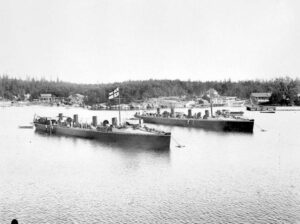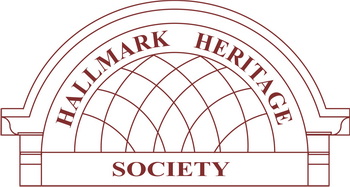THE SECOND BATTLE OF COLWOOD
Daily Colonist – September 4, 1901
CAPTURED THE FORT
Brilliantly Executed Movement Results in a Victory for the Navy.
Invaders Demand Million Dollars Indemnity Under Pain of Bombardment
How the “Handy Men” Drove the Defenders Through Colwood
(By Our War Correspondent at the Front.) Colwood Sept. 2 (Delayed in transmission)The naval and military manoeuvres which have ended with the capture of the Rod Hill fortifications and with the domination of the city of Victoria by a hostile squadron, which is threatening to bombard and raze the city to the ground unless the sum of one million dollars indemnity is forthcoming, have demonstrated many things, notably, the everlasting handiness of the “handy man.” While the main force of 135 officers and men from the fleet were forcing back the defenders through the village of Colwood, a flying column of 67 officers and bluejackets went via a trail to the E. & N. railway, commandeered the train, and forced the conductor to carry his party to Parson’s Bridge, which was blown up and burnt (theoretically), and then capturing the sternwheeler Water Lily, the flying column landed at the rear of the forts, which they reconnoitred and found practically deserted. They then captured the forts, and signalled their success to Capt. Pike, who was in command of the naval fleet of the T.B.D. Virago and torpedo boats 39 and 40 TB 39 and TB 40 100 Footers purchased from Yarrow & Company Limited., representing a fleet of three cruisers, and he at once sent word to Acting Mayor Williams, that unless one million dollars indemnity was paid within twenty-four hours the city would be Bombarded and razed to the ground. The acting mayor has refused to surrender, and as the 24 hours have elapsed, the bombardment may be expected at any moment.

It was 5 a.m. on the morning of Monday when the attacking party left Esquimalt, and disembarked below Albert Head, under cover of a flanking party at 5:45 a.m. The protection of the flanking party was, however, unnecessary, for the landing party was unopposed. Sentries and pickets were posted, and then the enemy bivouacked and had breakfast. Breakfast had been concluded some time when sentries sent back word that the defending force was landing at the lagoon near Albert Head. This force consisted of the Sixth Rifles of Vancouver and New Westminster, under Lt.-Col. Worsnop, and the Royal Engineers, under Lieut. Elliott. An hour after the defence had landed, the enemy, 202 strong, formed their order of march. The main force was made up of six petty officers, 68 rifles, 3 pioneers, 6 explosive party, 8 stretcher party, 7 officers, 1 marine officer, 28 marines and 8 with spare ammunition, 135 officers and men; and the flanking party was made up of 3 petty officers, 38 rifles, 4 spare ammunition, 6 explosive party, five cyclists, and 1 officer, 8 officers and 3 pioneers, 67 officers and men. The marines acted as advance guard. No. 1 Co, leading, the pioneers, explosive party and spare ammunition party were in the centre, and No. 2 Co, were in the rear, followed by the ambulance party, and following with a good rear guard.
It was 10:15 a.m. when the enemy came into touch with the defence, and then the fusillading began. The defenders valiantly tried to hold back the advancing bluejackets, but soon they were travelling backwards, dropping on their knees to fire, and then while each small company protected the other’s retreat, they retired rapidly before the quick advance of the “handy men.” The Sixth developed into fine sprinters, and as the sun was throwing some torrid rays through the tall trees, they perspired freely as they travelled back before the oncoming forces of the enemy, who stopped only to put in a withering fire now and then.
In the running fight –it was practically that –one of the defenders was captured, and he was told off with others the blow up the bridge on the Albert Head road, at 10:20 a.m., and ten minutes later the marines dropped back to form the rear guard, and the right half company of No. 1 forced the advance guard. Then the march proceeded, the enemy, as did Caesar of old, burning the bridges behind them, theoretically speaking, of course. All communication was cut off with them, and it was only when the occasional fusillading was indulged in between them and the defenders that the defence gathered knowledge of their position. Thus the enemy came on in their attack, until 10:30 a.m., one of the umpires — they were allowed to go through the lines of both parties — went to the advancing enemy and asked that the hostilities be suspended until further orders, as the defence was not in position.
The invaders and defenders were by then not far from the crossroads where the Happy Valley and Metchosin roads branch off from the main road. The bluejackets were hidden in the foliage and only their straw hats could be seen here and there by the Sixth rifles who were holding them. A short distance back at the junction of the roads was a small force holding the roads under Capt. Tite, and here all wayfarers were halted. Further back at the Colwood hotel were some officers, amongst whom was Lieutenant Kilpatrick of Strathcona’s Horse and Major J.E. Ward Leckie of the 8th New Brunswick Hussars, who had been attached for duty, and not far back was the rear guard.
It was at the Colwood hotel that the wayfarer from the city first came in contact with the war, and it was here that the force of A Company, which captured the forts last year, dodged the pickets. The first glimpse of the strife which came before the vision of the Colonist Correspondent was a couple of officers standing on the verandah of the hotel figuring out where they were on the field map, when one was not bending down while the other loosened cigarettes from his cartridge pouch. Thus they were engaged when a scout rode up on a wheel and reported, and then they hurried forward to the front.
They were nearing the post under Capt. Tite when one of the enemy’s scouts fell into the force there. A young midshipman was riding gaily along the Happy Valley road all ignorant of the proximity of the enemy he had passed two of their sentries when suddenly he came within view of the post. He dismounted hurriedly and tried to run, but the cyclists of the defenders were too quick for him and brought him in. He was taken before Capt. Tite, stripped of his equipment and questioned, but he failed to reveal any intelligence, and was ordered to be taken to headquarters.

His guards had not gone more than five of six hundred yards with him, in fact, they had stopped at Demer’s for refreshments, when there came the quick rattle of rifle fire, and over the crest of the hill came the riflemen on the run. Following them were the dust covered bluejackets, their plainly marked straw hats seen in a line amongst the foliage, and the way the smoke belched forth and the rifles rattled it was evident that there was a large body of “handy men” sweeping forward over the hill. The Sixth began to sprint, and right through the village of Colwood they were driven step by step by the sailors.
It was a splendid spectacle. There on the dusty road kneeling in an all too solid looking double line was the main body of the enemy and thrown out in the fields on either side were two flanks, they were putting in a withering fire as they jogged along, pressing the defenders back. The defence was split up in small detachments, widely extended with two long flanks in the fields on either side of the road, and each detachment kept up a fire only long enough to allow the retirement of that nearby. On and on came the sailors, and a cloud of smoke stood over the fields of peaceful Colwood, sleek looking kine hurried from the pastures terrified by the fusillading and chickens scurried in terror from the path of the invading forces. It was such a battle as Colwood has never seen and may never see again.
The Sixth were developing into sprinters of no mean ability, and the manner in which their two flanks climbed fences heedless of rent trousers, was marvelous. Those wayfarers who were unfortunate enough to be caught between the columns, and a Victoria clergyman was among these, had a trying time. “Bullets to the right of him, bullets to the left of him, volleyed and thundered” he was shot through the back and through the front, and his horse betrayed an unmistakable anxiety to plunge forward in a mad race for life, which was only prevented by the well known parson holding to the animal’s head with a determined grasp. To detail all the incidents of this never to be forgotten battle of Colwood would take much space, however, and the majority must be left to the imagination of the reader.
Col. Worsnop suffered in this running fight — he had come up with the rear guard — and in his fast retreat over the dusty road. He perspired freely, and his handkerchief was oft on his perspiring brow. There was nothing for it but to keep travelling or be captured, and the Sixth travelled… for although the sailors were massed in too solid a formation and were (theoretically) being mowed down in numbers. They had the stronger force, and the rules of the game say that the weaker force must retire. The fortress company of the Royal Engineers with their scarlet tunics and white helmets had come up with Col. Worsnop’s force and rendered good service on the right flank, but over the greater part of the retiring line, the defenders were potting and sniping rather than firing systematically.
Demer’s — the Colwood post office– had been passed, and it looked as if the Sixth were on the run for Victoria when after some heavy firing, on either side, the bugles sang out the “cease fire” and the battle of Colwood was at an end, and although the defenders were not aware of the fact, the forts they had been defending had been in the hands of the enemy for over two hours. It had been arranged that the hostilities would cease at 1 p.m. and then the bugles blew “Cease firing.”
While the main body of the enemy had been held at the crossroads by the Sixth’s force under Capt. Tite, a flanking party of the naval force was in the fort and the commanding officer of the fleet had dispatched the following letter to Acting Mayor Williams:
“H.M.S. Sparrowhawk, 2nd September 1901.
Sir: The Fortifications of the City of Victoria having been demolished, I will have to demand that you will surrender the city of deliver to me the sum of $1,000,000 by 11 a.m. today (2nd Sept.) In the event of your refusing to comply with this demand I beg you will hoist the Geneva Cross over the hospital, which I will take as a signal that you have refused and I will immediately proceed with the destruction of your city.
G.Y.F PIKE, In command of H.M.S. Sparrowhawk.
To the Mayor, City of Victoria, British Columbia.”
To which the Acting Mayor replied as Follows:
Victoria, B.C. 2nd Sept., 1901
Dear Sir I am in receipt of your communication of today, and in reply would say as Britishers we have not yet formed the habit of surrendering, and I might further remark that in lieu of stumping up $1,000,000, we will hoist all the flags in the city of Victoria.
The flag demanded has been placed over the Royal Jubilee Hospital and the British Ensign raised on Beacon Hill. I am, sir,
Yours very truly,
R.T. Williams.
On Behalf of the Mayor
To Commander Pike, H.M.S. Sparrowhawk.”

The scheme whereby the forts were captured was a brilliant one. When the naval forces under Capt. Casement landed from the squadron near Albert Head they took ashore with them a Berthon collapsible boat, and after the flanking party had set out on their movement which ultimately resulted in the capture of the fortifications they commandeered a team of horses and a rig belong to a farmer near Albert Head, and with these carried their boat along the trail shown in the accompanying chart from the farms near the landing place, and thence along the road past the lagoon and over the Happy Valley road to where it joins the Sooke road, and near the junction of these a trail is shown on the map. Over this trail the flanking party proceeded, having (nominally) cut the telegraph communication with Victoria. Two officers and one man were dispatched to the water in disguise with instructions to seize all row-boats they could find and to proceed to Parson’s Bridge and blow it up.
They succeeded in carrying out the plan to the detail as evidenced by the following report made by Lieut. Murray, the officer commanding the flanking party, which reads “at 6:30 a.m. Left Albert Head with Newton and one stoker. 8:10 a.m. captured Water Lily. Proceeded to Parson’s Bridge. 10:20 a.m. blew up Parson’s Bridge with Col. Holmes on it. Also burnt it. Destroyed telegraph posts and wires.” And Col. Holmes laughed heartily to hear of the manner of his death.
The trail over which the flanking party proceeded from the Happy Valley road a trail discovered while reconnoitering the day before leads to the E. & N. railway, and arrived there the party of naval men awaited the coming of he morning train, which they stopped and commandeered. This was some distance west oft the Goldstream Crossing. The train thus held up was ordered by its capturers to convey them to Parson’s Bridge. Theoretically the railway line was blown up and the railway telegraph destroyed. All had gone well, but then as they were about to make good their successes the flanking party observed signalling, a flag was being “wig-wagged’ on a nearby hill, and fearing that they were discovered, the at once abandoned their Berthon boat, leaving an officer and a couple of men with it, and started a force march for Parson’s bridge.
They party left in charge of the boat had commandeered a team from a farmer and taken the boat to the water and brought it around to Parson’s Bridge, arriving there about the same time as did the full force of the flanking party.
At Parson’s Bridge the old sternwheeler Water Lily which had been captured earlier by the three men sent out to blow up Parson’s Bridge, was found, and on this vessel the party embarked and landed on the shore some distance to the rear of eh forts on Rod Hill. There they prepared for the attack. First a reconnoitering party was sent out and this party made its way practically to the fort, and finding that there was no defense in the fortifications the defenders having seemingly trusted that their screen would not be penetrated they returned and reported to the officer in charge. Then the party of 67 officer and men of this flanking party advanced into the forts, which were undefended excepting for the presence of some gunners lounging about in fatigue uniform, who were not taking part in the manoeuvres.
The enemy then quickly demolished the defence works in the forts with the explosives brought with them, dismounting the guns, and destroyed things generally, in fact, they acted as would any invader who won the same advantage, and then heliographed their success to Lieutenant Commander Pike on the Virago, which represented the flagship of the invading fleet. The Lieutenant Commander then dispatched his message to the city demanding one million dollars indemnity, to which the Acting Mayor replied “No Surrender,” and the Red Cross flag was hoisted on the Jubilee hospital, wither (nominally) all the women and children are being hurried in view of the expected bombardment.
The scheme for the capture of the forts was told the night before to one of the umpires, and he laughed at it, remarking that it was a fine idea, but almost impossible to carry out. However it was carried out, and as said above demonstrates the everlasting handiness of the “handy man.”
Thus ended the capture of eh Rod Hill forts. At night an attempt was made by Lieut. Commander Pike to enter the harbor of Esquimalt without detection from the forts, but the fine moonlight night gave the harbor runners little chance of success, and the attempt failed. The searchlights operated from the forts picked up the incoming torpedo boats easily and the night attack was a practical failure.
Lieut. Commander Pike adopted a scheme which under weather conditions different from those Monday night might have been successful. He secured a scow on which was loaded a number of bales of wet hay, and these were used to make a smudge which would throw a curtain of smoky fog over the torpedo boats but there being no wind what ever, not even a slight breeze, the smoke arose straight up, and the moonlight being also against the chance of success, the search lights easily found the enemy, and the flotilla could not enter the harbor.

While the battle of Colwood progressed a small number of the officers and men of the Fifth Regiment but 34 all told were engaged in practice with the six inch guns and Maxims at Fort Macaulay. They were dismissed at noon.
